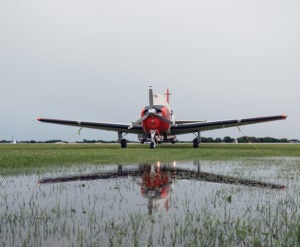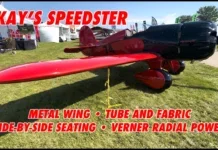
I heard Jester’s coarse voice and felt the impact of each syllable, “You. Nev-er. Leave. Your wingman.” I’m foreshadowing the past, though, so let me begin again. AirVenture is nigh. Aviation’s summer pilgrimage to Oshkosh resumes. Many of us are out of practice flying to foreign soil for an extended stay. Even before the gap year, pilots planned their OSH arrival, but few, I think, really planned their OSH departure. I give little thought to either. I taxi a quarter-mile from the east side of the airport to the airport’s west side, where I’m welcomed to my hometown by a flag-person from Vancouver. When I flew to Sun ’n Fun, I’ll admit, my LAL departure planning was little more than a fingers-crossed return date and watching the nation’s weather from the moment I landed. For that, I eventually paid a price.
Arriving Is Optional, Departing Is Inevitable
One year, at Sun ’n Fun’s end, I planned to follow a friend to his home in North Carolina before continuing to Oshkosh. When a weather system over Kansas began to threaten Northern Illinois (“Call me weak again and I’ll show you nimbus.”), we decided to take wing two days early. Distracted by the weather forecast and our advanced departure, I wasn’t focused during preflight and failed to sump the fuel tank. As a flag-person guided my wingman to the runway, my starter devoured the battery’s cold cranking amps while the engine spat out water like a Spaghetti Western gunslinger who’d been served watered-down rye. While I orchestrated a jump start, my wingman was intercepted by an alert scooter driver. I got started quickly but, while concentrating on the problem and my wingman’s probable confusion, I lost more focus. On climb-out, I saw I had less fuel than I thought. I had failed to know how much fuel I had. Many lessons were learned.
Preparing for an AirVenture arrival is a must. There is no way to arrive at the world’s busiest airport casually. In the excitement of planning your arrival, the inevitable departure can be overlooked like a quiet child at a kid’s birthday party. Every year, as AirVenture comes to a close, I see a worried-eyed aviator with racing heart, mind and legs, trying to track down a tool, a part or help to get their disabled airplane repaired. Or they’re panicked as they—I was going to say prepare, but the time for preparation had passed—try to bug-out at the approach of a darkening mid-day horizon. That’s not the time to call a fuel truck or discover your AirVenture souvenirs and wet, rumpled gear won’t fit in the airplane.
Pre-Arrival Departure Preparation
Many departure preparations can only be made after arrival, but they can be anticipated now. To begin, dig out your archived January 2020 issue of KITPLANES® and reread “Spare the Wait and Carry On.” That will get you on track packing the tools and parts that can keep a simple failure from becoming extra nights in a tent. If your airplane’s battery is kept on a battery tender, unplug it to see if it can start the engine after a week off the juice. It’s better to identify a failing battery at home than at AirVenture, after the vendors are packed up or sold out, and the volunteers with jumper cables are at Herbie’s Acee Deucee celebrating another successful week. Bring tie-downs with you. They’re required for all aircraft because damaging winds also visit Oshkosh each July. The peace of mind of landing with tie-downs versus sourcing them on-site is worth their weight. Speaking of weight, reserve cargo capacity for the added weight and volume you’ll schlep home. Clothes and camping gear weigh more wet than dry. A six-pack of Spotted Cow weighs 7.5 pounds. A 12-pack of cans? Even more.
Post-Arrival Departure Preparation
Other than your hangar, there’s no better place than AirVenture when your homebuilt needs service. Identifying a problem while vendors still have tools, parts and fluids is key. Parts specific to your airframe (tail caster, nose fork, axle), however, can be more difficult to find. Few kit manufacturers bring spare parts to shows, but they may be able to expedite delivery to Oshkosh. Another pilot may have the part you need packed with their spares. “Is there an A&P or a welder in the house?” Of course there is, including the volunteers at EAA Chapter 75’s Emergency Repair Barn, who can help you make a repair.
Identifying a problem early provides the luxury of time and resources to make an unhurried repair. Before you shut down, do a mag check. After you shut down, triple-check that the master switch is off. Things seldom break sitting for a week, so perform a walk-around before you walk away. Check your tires. If they’re inflated 24 hours after landing, they’ll still be inflated when you depart. Open the cowl and poke around. Check the oil. Fuel up, but leave room for expansion. The same sun that melts your ice cream, and your will to walk through another exhibit building, heats and expands fuel. I saw a Cessna stream fuel onto parched grass like an overserved Packers fan.… Never mind.
Please, prepare for your AirVenture arrival. Know the NOTAM. Study the Fisk arrival procedure. Approach Oshkosh with enough fuel to orbit or divert to another airport if necessary. Stay alert for traffic in the crowded sky; not all traffic shows up on ADS-B (your screen will be painted solid with targets, anyway). Practice slow flight. Practice spot landing (“Red Experimental, land on the green dot. Traffic is landing behind you. Welcome to Oshkosh.”). After you tie your airplane down, after your mind clears and you get those first full lungs of Oshkosh’s fragrant summer air, enact your plan for departure. We all love to hear, “Welcome to Oshkosh.” It’s also nice to hear, “Welcome home! Did you get some Spotted Cow?”













